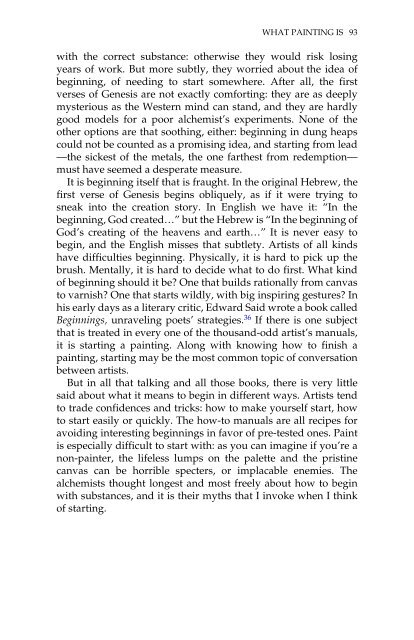What Painting Is: How to Think about Oil Painting ... - Victoria Vesna
What Painting Is: How to Think about Oil Painting ... - Victoria Vesna
What Painting Is: How to Think about Oil Painting ... - Victoria Vesna
Create successful ePaper yourself
Turn your PDF publications into a flip-book with our unique Google optimized e-Paper software.
WHAT PAINTING IS 93<br />
with the correct substance: otherwise they would risk losing<br />
years of work. But more subtly, they worried <strong>about</strong> the idea of<br />
beginning, of needing <strong>to</strong> start somewhere. After all, the first<br />
verses of Genesis are not exactly comforting: they are as deeply<br />
mysterious as the Western mind can stand, and they are hardly<br />
good models for a poor alchemist’s experiments. None of the<br />
other options are that soothing, either: beginning in dung heaps<br />
could not be counted as a promising idea, and starting from lead<br />
—the sickest of the metals, the one farthest from redemption—<br />
must have seemed a desperate measure.<br />
It is beginning itself that is fraught. In the original Hebrew, the<br />
first verse of Genesis begins obliquely, as if it were trying <strong>to</strong><br />
sneak in<strong>to</strong> the creation s<strong>to</strong>ry. In English we have it: “In the<br />
beginning, God created…” but the Hebrew is “In the beginning of<br />
God’s creating of the heavens and earth…” It is never easy <strong>to</strong><br />
begin, and the English misses that subtlety. Artists of all kinds<br />
have difficulties beginning. Physically, it is hard <strong>to</strong> pick up the<br />
brush. Mentally, it is hard <strong>to</strong> decide what <strong>to</strong> do first. <strong>What</strong> kind<br />
of beginning should it be? One that builds rationally from canvas<br />
<strong>to</strong> varnish? One that starts wildly, with big inspiring gestures? In<br />
his early days as a literary critic, Edward Said wrote a book called<br />
Beginnings, unraveling poets’ strategies. 36 If there is one subject<br />
that is treated in every one of the thousand-odd artist’s manuals,<br />
it is starting a painting. Along with knowing how <strong>to</strong> finish a<br />
painting, starting may be the most common <strong>to</strong>pic of conversation<br />
between artists.<br />
But in all that talking and all those books, there is very little<br />
said <strong>about</strong> what it means <strong>to</strong> begin in different ways. Artists tend<br />
<strong>to</strong> trade confidences and tricks: how <strong>to</strong> make yourself start, how<br />
<strong>to</strong> start easily or quickly. The how-<strong>to</strong> manuals are all recipes for<br />
avoiding interesting beginnings in favor of pre-tested ones. Paint<br />
is especially difficult <strong>to</strong> start with: as you can imagine if you’re a<br />
non-painter, the lifeless lumps on the palette and the pristine<br />
canvas can be horrible specters, or implacable enemies. The<br />
alchemists thought longest and most freely <strong>about</strong> how <strong>to</strong> begin<br />
with substances, and it is their myths that I invoke when I think<br />
of starting.


